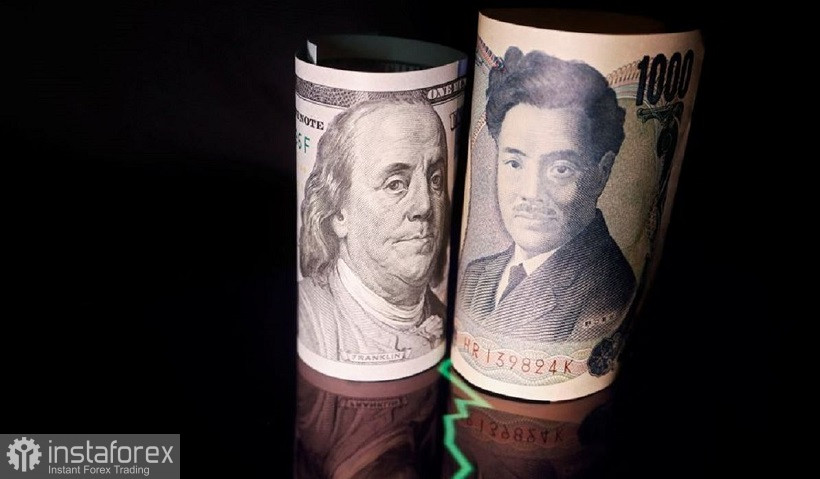The USD/JPY pair is trading in the 100-point range of 136.50-137.50 this week, alternately starting from the boundaries of this price range. This "stability" allows you to go into long positions at the lower end of the range and, accordingly, into shorts – at the top. But this uncomplicated strategy contains a serious flaw – serious price turbulence is expected in the foreign exchange market at the end of the trading week, in the epicenter of which dollar pairs will be. And the USD/JPY pair will not be an exception here.
So, the market will focus its attention on two events. Firstly, Federal Reserve Chairman Jerome Powell's speech at an economic symposium in the American city of Jackson Hole. Secondly– the release of the PCE index. It is difficult to overestimate the importance of these fundamental factors, especially in light of the heated discussions about the further pace of tightening of the Fed's monetary policy. If Friday's events resonate (the index will be released in the green zone, and Powell will voice an "ultra-hawkish" attitude), the dollar will again be in high demand across the entire spectrum of the market. However, an alternative scenario is not excluded, when, amid a slowdown in the inflation indicator, the head of the Fed will take a restrained position, voicing vague formulations. In this case, the greenback will fall under a wave of shorts, as it was at the end of the July Fed meeting.

Let's start with American statistics. So, the main index of personal consumption expenditures (PCE) will be published on Friday. This is one of the key inflation indicators that is closely and even biasedly monitored by members of the Fed, and which can provoke increased volatility among dollar pairs – both in favor of the dollar and against it.
According to most analysts, Friday's report will reflect a slowdown in the growth of the index. For example, on an annual basis, the indicator should reach 4.6%. Despite the fact that this is still a high value for PCE, the trend itself is important here. Let me remind you that after a three-month decline, the basic price index of personal consumption expenditures in July still raised its head, ending up at 4.8%. If the PCE reverses 180 degrees again, the dollar may be under significant pressure, amid slowing CPI and producer price index growth. The growth or slowdown of the PCE index will play an important role, especially in the context of Powell's speech, who may express his position on the further pace of tightening of the Fed's monetary policy.
It is worth noting that ahead of Powell's speech on Friday, the market has screwed itself up quite a lot, reacting to hawkish statements by Fed representative James Bullard and some of his other colleagues (Bowman, George, Bostic). They did not rule out the option of a 75-point rate hike, and Bullard directly announced that he would support this proposal at the September meeting (this year he has the right to vote in the Committee). Also, market expectations rose amid fairly strong Non-farms, the components of which came out in the green zone. For example, the number of employed in July increased by 528,000 with a forecast of 250,000 growth. Therefore, despite the slowdown in CPI growth, dollar bulls are very optimistic. The CME Group FedWatch Tool says that the markets estimate an almost 50 percent probability of a 75 basis point rate hike in September.
Powell can either play along with dollar bulls, thereby strengthening the greenback's position, or overthrow the dollar throughout the market. If he voices a restrained position regarding the further pace of monetary policy tightening, USD/JPY bears will get a reason to overcome the support level of 136.50 and further test the 135th figure. Let me remind you that at the final press conference after the July Fed meeting, Powell refrained from making any specific forecasts regarding the pace of rate hikes this year. At the same time, he was skeptical about the prospects of continuing aggressive tightening of monetary policy.
According to him, the US central bank may resort to another "unusually large" rate hike at the September meeting, "if the inflationary pressure on the economy does not weaken sufficiently by autumn." Answering clarifying questions from journalists, the head of the Fed noted that a more active rate hike (meaning a 75-point increase) "it may take place at one of the future meetings, if the incoming data will be conducive to this." Otherwise, the Fed is likely to abandon the aggressive pace of monetary policy tightening.
If Powell makes such theses on Friday, the dollar will lose an important advantage of a fundamental nature, which allows it to hold its positions – including in the USD/JPY pair.
Separately, it should be noted that the dynamics of the pair depends on the dynamics of the US currency. The yen does not act as an independent player here, due to the ultra-soft position of the Japanese central bank. Therefore, the fate of USD/JPY is in the hands of the US dollar.
Taking into account the high degree of uncertainty, it is advisable to open trading positions on the pair after Powell's speech and the release of data on the growth of the PCE index. These fundamental factors are able to "rescue" the pair from the range of 136.50-137.50. To the upside or downside is an open question.
 English
English 
 Русский
Русский Bahasa Indonesia
Bahasa Indonesia Bahasa Malay
Bahasa Malay ไทย
ไทย Español
Español Deutsch
Deutsch Български
Български Français
Français Tiếng Việt
Tiếng Việt 中文
中文 বাংলা
বাংলা हिन्दी
हिन्दी Čeština
Čeština Українська
Українська Română
Română

